Setting proctoring parameters in Canvas
- Click on “+” inside the new module:
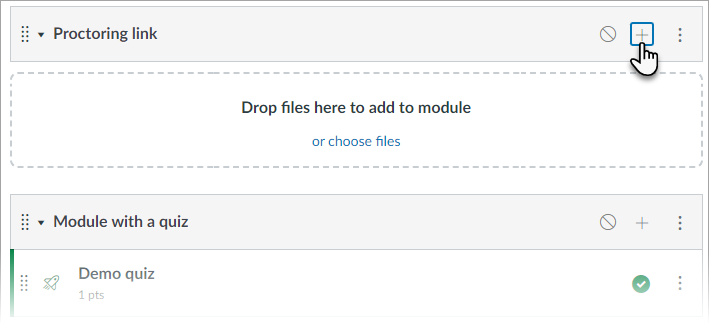
- Select External tool (1) and click on Constructor Proctor (2), then click Add Item:
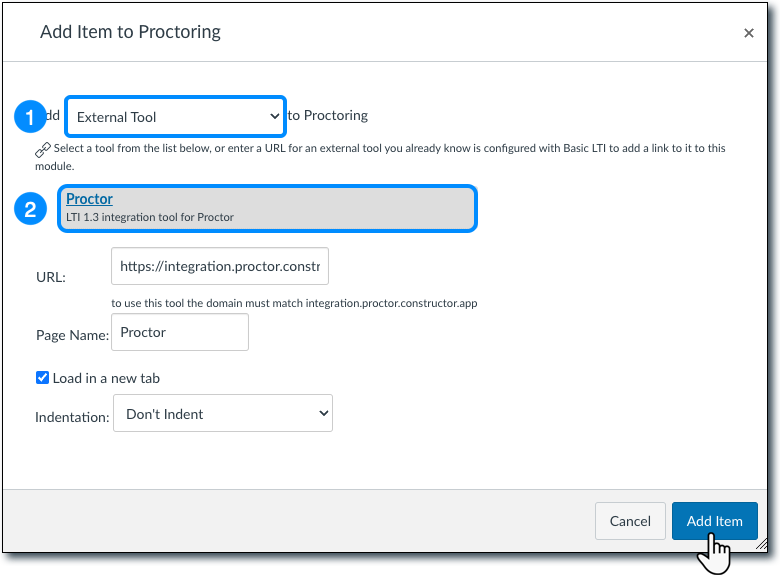
| Information | If you are testing the solution on Constructor Canvas testing environment, select Proctor_new_integration. You can disregard the other listed tools. Once Proctor is integrated with your organization’s Canvas environment, you will have only one integration option to select at this stage. |
- Click the new item in the module:
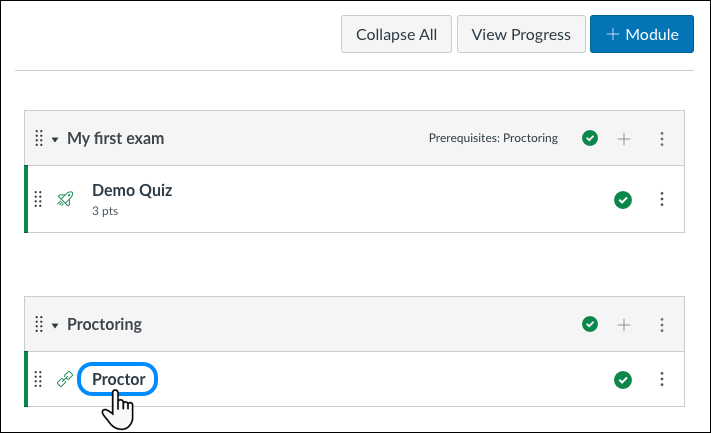
- Click Load Proctor in a new window:
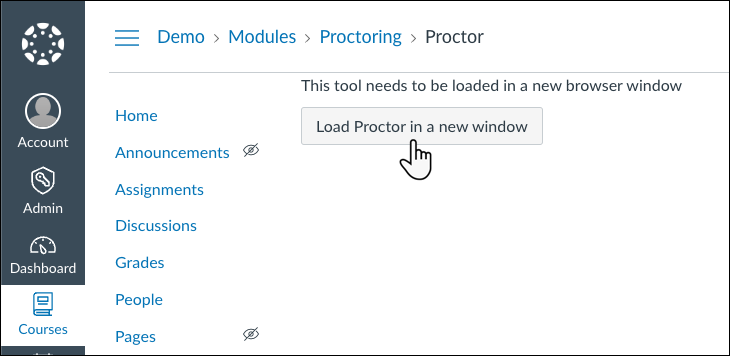
- A new window will open. Click Add exam at the bottom to create a new proctored exam:
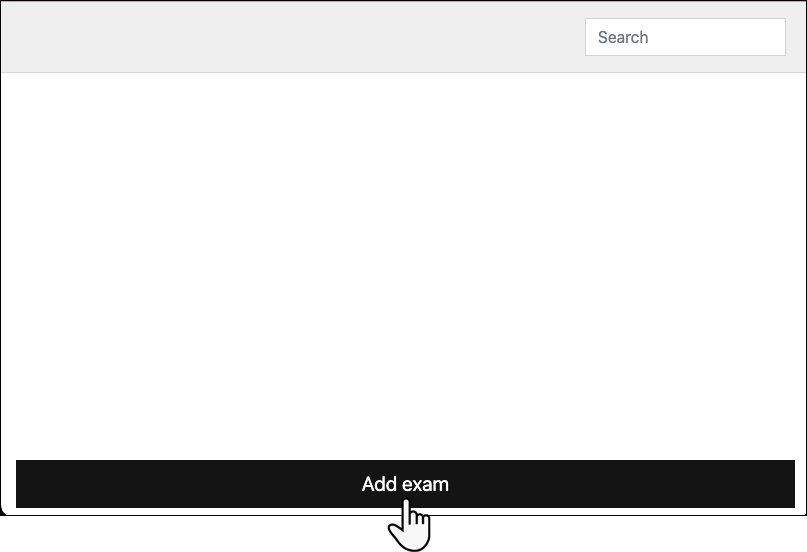
- Set proctoring parameters for the exam as needed. You can find the details about each of the parameters in the table below.
Important requirements for Proctor and Canvas exam integration
For the integration of Proctor and Canvas to operate correctly, make sure to:
- Select the quiz you want to associate with this exam.
- Enable Secure Browser.
- Use the same password for this exam as the one set in the quiz.
If any of these actions are missed, the integration will not function correctly.
Exam parameters:
| Parameter | Description |
|---|---|
| Title | Name of the proctored exam that will be saved in the Proctor Dashboard. |
| Exam resource | The quiz that you want to associate with this exam. This requires you to have a quiz already created in the Quizzes section of the course. |
| Proctoring mode | • Offline: multiple examinees take the test at a certain time. AI gives warnings and records found violations to the archive. Human proctors identify students before letting them start the exam. They are watching the examinees in real time (8 examinees per proctor by default), are able to manually add violations, and either confirm or reject authenticity of each exam session in real time. • Online: examinees take the test at any time that suits them individually. AI gives warnings in real-time and records found violations to the archive. After the exam is finished, proctors can watch recorded sessions in the archive, manually add violations, and either confirm or reject authenticity of each session. • Auto: same as Offline, but AI is able to confirm or reject authenticity based on the automatically calculated cheating score (see further in the list). No human proctor involvement needed. • Identification: same as Post-Review, but human proctors need to identify students before letting them start the exam. |
| Identification mode | Determines what photos are requested from students before the exam starts: • Passport; • Face; • Face and Passport; • Skip - do not request any photos. |
| Duration | Duration of the proctored exam. The exam will not stop automatically if this duration is exceeded. If you want to put a limit on exam duration, apply Timing settings instead. |
| User agreement url (optional) | Use custom HTML if you want to alter the agreement page displayed to examinees before the start of an exam. |
| Start date (optional) | Currently not functional. |
| End date (optional) | Currently not functional. |
| Auxiliary (secondary) camera | If enabled, students will have to use their smartphone as a second camera. |
| Allow multiple displays | If enabled, examinees will be able to start the exam with more than one display connected to their computer. |
| Allow virtual environment | If enabled, examinees will be able to start the exam on a virtual machine. |
| Check id photo quality | If enabled, AI will attempt to check if the ID photo is readable (text is clear). |
| Web camera main view | • Front – examinees will have their webcams in front of them. This is default. • Side – examinees will have their webcams set on the side. |
| A calendar entry is required | If enabled, an Proctor calendar entry is needed to take for the exam. |
| Calculator | Applicable only if Secure Browser is ON. If enabled, then during the exam, students will have access to a built-in calculator in Secure Browser. |
| Secure Browser | If enabled, the exam can only be taken in Constructor Secure Browser. This parameter needs to be enabled, for the Proctor and Canvas integration to work correctly. |
| Secure Browser security level | Choose which security level is used in Secure Browser. • Basic: same features as in webapp (Google Chrome / Edge experience) plus virtual machine detection, USB devices detection (additional keyboards, mice, etc.) during exam. • Medium: same as in basic level plus screen capture prevention on Mac, can kill app processes before and during exam based on a white / black list, resizing the secure browser is not allowed. • High: same as in medium plus blocks certain OS keyboard shortcuts (Alt+tab, Win+R, Print Screen, etc.), forced full screen (kiosk mode), Always displayed on top of other apps. |
| Exam password | The same password you set for the examm quiz (for example, if you have set the quiz password to 123456, you need to fill in this field with 123456). |
| Rules | Select which exam rules should be seen by examinees before the session starts. Note that a small number of rules disables the “Exam page lost focus” full-screen overlay when enabled. These rules are: • Allow to use websites • Allow to use excel • Allow to use messengers Custom rules**😗* enter any text you would like to show to examinees in the rules section |
| Visible Warnings | Turn AI alerts that are displayed to examinees on or off |
| Scoring | Customize the individual weight that each AI-detected violation type will contributed to the automatically calculated cheating score. For initial testing it’s recommended that you leave the values in this category as is. |
Now you can set up a requirement for the proctoring module and a prerequisite for the quiz module in order to make it impossible to launch the quiz without proctoring.
An alternative way to solve this concern would be to add a password for the quiz in Canvas settings, and then include this password into Custom exam rules. However, this will not prevent learners from sharing the password with their peers if their exam starting times are different.